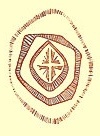A Catholic website for the modern reader

The Sign of Peace—A Sign of Touch
By
Fr. William Messenger
As adults, we often find that we can learn a good deal of simplicity and wisdom from children. This is particularly true in developing a sensitivity to touch. In the busy, intellectually oriented adult life, we tend to forget that we first learn of the world through touch. How many of us have held a baby only to have our hair pulled, or feel a firm grip on a finger, or even to be playfully hit in the face? This is one of the ways a baby comes to know about people and things--by touching.
How many of us as children would ride our bicycles or skate alongside a chain link fence, dragging one hand all the way along the fence? This helps us learn what a chain link fence really is, and it supplies us with the sensation of touch.
But touching is more than a learning experience. Through it, we both experience and express love. When little children enter a room in which they find their parents, relatives or friends, they immediately run up, hug, and kiss them. Little children are not content sitting in their own chairs. They want to sit on or next to someone else holding onto someone else's arm. These are acts in which children both express their own love, and experience the love of others. This is touch most beautiful and most creative, for it draws individuals out of the circle of their own existence into contact with others, allowing the possibility for oneness to occur.
In reaching out to others, we draw them not only to ourselves, but into ourselves. At the same time we allow others to draw us into themselves. Reaching out and touching others affords the possibility of becoming one, of creating a new unity. When the woman who suffered from a hemorrhage came close to Jesus, she did not want to talk to him. She only wanted to touch his coat, believing that would be sufficient. And it was! By touching his coat she drew his healing power into herself, and cured her illness.
We picture Jesus holding out his hand and saying, "Come to me, all you who are weary and find life burdensome, and I will refresh you." In the Crucifix, we have traditionally seen Jesus' outstretched hands as a symbol of his reaching out to draw all people to himself. This touching culminates in the Eucharist when Jesus invites us to "Take and eat, this is my body."
The Church gives each of us the opportunity to share in creating this unity and preparing for the Eucharist. During the Liturgy, the priest extends from the altar "the peace of the Lord." But peace is not something personal that we share as individuals with Christ. It is the force that binds us together: "Make every effort to preserve the unity which has the Spirit as its origin and peace as its binding force" (Ephesians 4:3). If we are united to Christ, we are united in Christ, and the peace we experience must be shared. So we turn to those beside us, and reaching out--we touch them--sharing the peace we have in Christ with them. They, in turn, reach out and touch us, sharing the peace they have in Christ with us. This, once again, is touch most beautiful and most creative, for it draws each of us out of ourselves into a unity that has the Spirit as its origin and peace as its binding force.
The particular sign will depend upon the personal relationship that exists between people. Certainly a handshake is universally accepted. In closer relationships it may vary. But whatever the physical expression, the Sign of Peace is a Sign of Touch.
(Fr. William Messenger is a priest in the Archdiocese of Los Angeles)
(This article originally appeared in The Tidings, the Catholic newspaper for the Archdiocese of Los Angeles)
